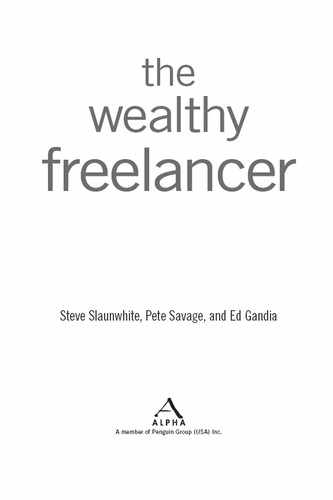Goal-Setting Made (Very) Easy
So how do you go from having a general sense of what appeals to you to setting specific goals you can strive for? You’re going to like the answer: use your imagination!
Think about it. All goal-setting is, really, is the use of your imagination to create a vision for your future. That’s it!
Weatlhy Words
Most freelancers I know do not have a business vision. That’s unfortunate because your business vision defines the business life you want to live. Your business plan includes the concrete objectives and marketing tasks that support your vision, but it all starts with your business vision.
—Paul Lima, freelancer writer, trainer, and author
Here’s a practical (meaning you’ll actually do it) goal-setting exercise you can do to get clear on what you want out of life. This is one of the easiest techniques I know for getting your goals down on paper, in part because it’s only three steps:
1. Envision your ideal day.
2. Compare and create your ideal and current days.
3. Prioritize and execute.
This exercise is especially enjoyable for freelancers. You’ll see why.
Envision Your Ideal Day
Freelancers have a whale of a time with this first step because we revel in the idea of doing what we want, when we want. So have fun with this exercise! Ask yourself, if you could create the perfect workday for yourself, what would it look like? What sort of work do you want to be doing? For what sort of clients? At what times during the day? Does your ideal day include a 60-minute workout at the gym or a 30-minute jog in the park? If so, schedule it in!
Picture every component of your ideal day in vivid detail, describing what you would do from the moment you wake up until your head hits the pillow. Outline your day in half-hour or hour increments.
When you’ve mapped out your ideal day, have a look at it and realize this, your ideal day, is really a one-day snapshot of your ideal life! And this is a visual representation of your goals manifest. From this visual of your ideal day, you can extract a list of goals and keep them on a separate piece of paper.
Optional: Don’t stifle your own creative energies. Don’t stop at imagining just one day if you don’t want to. Heck, go ahead and create the ideal year if you want to. You don’t have to map out all 365 days, but you can certainly ask yourself what kind of vacations you’d like to take, how much time you’d like off, what your weekends would look like, etc. Get as carried away as you like with this exercise, but stop when it starts to feel like a chore.
Compare and Create
When you have your ideal day mapped out, compare it to how you currently spend your days and note the differences. Now create a list of all the things you can do to bridge those differences. What do you need to do, starting right now, to make your ideal day—that is, your ideal life—a reality?
Write down anything and everything that comes to mind. I bet you’ll fill a page, if not an entire notebook, with creative ideas. These ideas will become more refined if you break up this step over a few days.
Prioritize and Execute
If you placed no limits on your thinking during step 2, you’ll end up with a giant list of ideas, notes, tasks, projects, plans, and even new goals to strive for. In all, you could have 20, or 120, different items on this giant list. Now you need to prioritize these items into a manageable list of “Things to Do.” As you prioritize, you can discard any items that turn out to be of little use.
Decide on a deadline for achieving your ideal day. Three years from now? Ten years from now? Knowing this helps you set mini-timelines for executing your list of Things to Do. For example, which tasks can you accomplish by the end of this month? This calendar year? Which can you accomplish next year? And so on.
Because Dan O’Brien always carried around his list of goals, he could review them regularly and stay focused on what was important to him. You can apply the same principle. Carry an index card around with you in your purse or wallet if you’re so inclined. Write your ideal day on one side and the extracted goals on the other. Or at the very least, print out your ideal day and your goals list and hang them in your office so you glance at them for a motivational boost several times throughout the day. It will help keep you on track.
And if your idea of the ideal day changes as time goes by, that’s terrific. It means you’re developing a clearer vision of how you truly want to spend your time. Simply modify the details of your ideal day when you need to and create new “to dos” to get you there.
Your Goals Should Never Be Etched in Stone
Even if you already consider yourself a gold medal goal-setter, this goal-setting exercise is worthwhile because it gives you a fresh perspective on your current goals, and it may lead you to make some modifications.
Having established goals to shoot for is critical to becoming a wealthy freelancer. While the achievement of your goals will no doubt be rewarding, the pursuit of those goals can—and should—be enjoyable. The next section on setting standards shows you how to get more enjoyment out of your freelance work.
..................Content has been hidden....................
You can't read the all page of ebook, please click here login for view all page.
